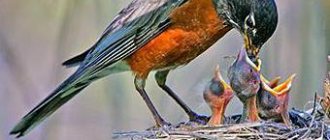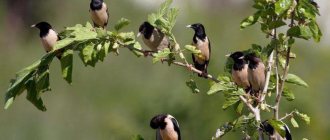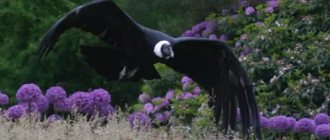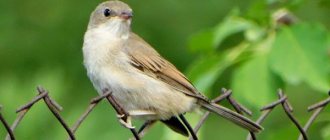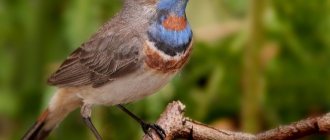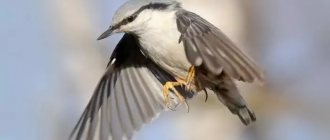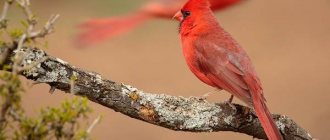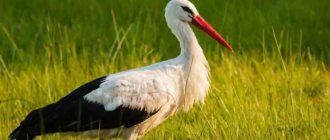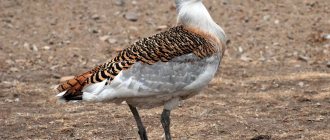- Wild animals
- >>
- Birds
The redstart is one of the most memorable birds living in parks, gardens and natural landscapes of Russia. For its spectacular bright tail, which is visible from afar, the bird received the name redstart. The contrast in color is more noticeable in males, while females and young birds have more pastel colors. However, a characteristic feature - a bright red swaying tail - is present in all birds.
Origin of the species and description
Photo: Redstart
The first formal description of the redstart was made by the Swedish naturalist C. Linnaeus in 1758 in the publication Systema Naturae under the binomial name Motacilla phoenicurus. The genus name Phoenicurus was designated by the English naturalist Tomos Forster in 1817. The genus and species name phoenicurus comes from two ancient Greek words phoinix “red” and -ouros “tailed”.
Interesting fact: Redstarts are typical members of the family Muscicapidae, as rightly indicated by the etymology of the scientific name, born from the merger of two Latin terms “musca” = fly and “capere” = catch.
The closest genetic relative of the common redstart is the white-browed redstart, although sampling of the genus gives some uncertainty to this. Its ancestors may have been the first redstarts to spread to Europe. They are thought to have diverged from the black redstart group about 3 million years ago during the late Pliocene.
Video: Redstart
Genetically, common and black redstarts are still quite compatible and can produce hybrids that appear healthy and fertile. However, these two groups of birds are separated by different behavioral traits and ecological requirements, so hybrids are very rare in nature. The redstart became the bird of the year in Russia in 2015.
Meaning for humans
Increasingly, people are attracting this species closer to villages. Birds settle in birdhouses and barns, adapting to a mutually beneficial neighborhood. The bird gets a cozy place to nest.
More and more often we come across notes that a bird with a red tail takes up residence in birdhouses or abandoned swallow nests. Birds bring invaluable benefits to humans by eating pests in gardens and summer cottages. And what is the value of the sweet, pleasing singing!
Interesting facts about the bird
- After fertilization, the male can begin courting several more females. This is normal for this bird species. It is noteworthy that he also takes turns flying in to care for the chicks. It happens that he flies to one nest more often, but rarely visits another.
- During the season, a couple manages to raise 2 broods. The second laying of eggs occurs in mid-to-late July. This way young birds will learn to fly well and become stronger for winter migration. The second clutch consists of 3-4 eggs.
- In case of danger awaiting a nest with chicks, the parents loudly shout “tek-tek-tek”, fly from branch to branch, try to attract attention and move them away from the chicks.
- It has been noticed that the bird does not welcome water treatments; to get rid of parasites, it bathes in dust. And he loves to bask: when he is not getting food for the eternally hungry chicks, he rests in the sun.
- It is interesting to watch how the female searches for food: she takes up an observation post on a hill, and then suddenly dives to the ground. It does not immediately swallow the prey, but eats it in a secluded place. The male most often hunts in flight.
- Keeping it at home is possible, but has some peculiarities. When placing a bird in a cage, its wings are tied up, otherwise it may get hurt by hitting the bars, trying to break free. They don’t live in twos, individuals fight. They get used to people poorly and sing little.
- In 2015, the redstart became bird of the year. This means that this year is devoted to the collection of phenological data, sharpening attention to the problems of the species population.
The bird that in the ancient fairy tale brought fire to people on its tail is it, the redstart. A little hardworking bird eats harmful insects and garden pests. Watching redstarts is a pleasure.
From spring to early autumn, they not only manage to raise a couple of broods of chicks, but also delight with their sonorous singing. Man, in turn, can help redstarts by building houses in which the birds will willingly settle.
Appearance and features
Photo: Redstart bird
The redstart is very similar in appearance and behavioral characteristics to the morning dawn. It has the same body length of 13–14.5 cm, but a slightly slimmer figure and a lighter weight of 11–23 g. The color of the orange-red tail, from which redstarts get their name, often fluctuates in color combinations. Among common European birds, only the black redstart (P. ochrurus) has a tail of the same color.
The male is strikingly contrasting in color. In summer it has a slate-gray head and upperparts, except for the rump and tail, which, like the flanks, underwings and armpits, are orange-chestnut in color. The forehead is white, the sides of the face and throat are black. The wings and two central tail feathers are brown, the remaining tail feathers are bright orange-red. The orange hue on the sides fades to almost white on the belly. The beak and paws are black. In autumn, the pale feathers along the edges of the body are hidden, giving the color a washed out appearance.
Females are discreetly colored. The upper surface is brownish. The underparts are light beige with a full orange breast, sometimes intense, which is clearly separated from the gray to dark gray chin and sides of the neck. The underside contrasts more clearly with the orange underside. The wings are brownish, like the male, the underside is beige with an orange tint. Her coloring lacks black and slate, and her throat is whitish. With age, females can approach the color of males and become more contrasting.
Varieties
The order of passerines of the flycatcher family includes 13 species of redstarts. The common feature is an awl-like beak and a fragile body build. The color of the tail feathers is also united by red in different tones.
Males are brighter than their female friends, who “wear” less colorful outfits. Having met a bird, you can easily find out who it is, focusing on the description of the male’s appearance.
Alashan redstart
The head is gray, the entire body and back are orange, the wings have longitudinal black and white distinct stripes. The species has been assigned the status “Near Threatened.” Habitat: Eurasia.
Red-backed Redstart
Named because of the brown color of not only the lower half of the body, but also the back. The head is black.
Grey-headed Redstart
A species close to vulnerable. Secretive, active mainly in the evening. The head, crop, wings are black, the underparts are white. There is gray hair on the head. The weight of an adult bird is 35-40 g. It lives in the subtropics and tropical forests. There are 2-3 eggs in a clutch.
Redstart
Apart from the brick-red tail, the entire body is black, interspersed with white.
Common redstart (coot)
The back is gray, the neck and cheeks are black, there is a white spot on the head, the belly is orange, and the tail is red. The most common type.
Field redstart
Black head, neck, back. The bottom is dark brown. There is a small white spot on the wing.
White-throated Redstart
The bright orange belly stands out against the background of the black back; on the head the blackness turns into a blue tint. There is a white spot on the crop. The wing has white and orange stripes.
Siberian redstart
The back and head of the bird are brown, the neck and crop are black. There is a white spot on the wing.
White-browed Redstart
Named because of the pronounced white stripe on the black head. The abdomen is orange.
Red-bellied Redstart
Head, back, neck, wings are black. There is a white cap on the head, the ends of the wings are also white. The abdomen is red.
Blue-fronted Redstart
Instead of a black head and back, this species has bluish plumage. The bottom is orange-brown.
Where does the redstart live?
Photo: Redstart in Russia
The distribution of this western and central Palearctic species is across temperate Eurasia, including the boreal, Mediterranean and steppe zones. In the southern parts, the nesting area is limited to mountains. In the north of the Iberian Peninsula, the redstart is not common; it is mainly found in the southern and western parts of it. There are cases of scattered nesting of these birds in northern Africa.
In the British Isles it occurs in the far east of Ireland and is absent from the Scottish Isles. In the eastern direction, the range extends to Siberia to Lake Baikal. Some small populations can be found even to the east of it. In the north, the range extends in Scandinavia to 71°N latitude, including the Kola Peninsula, and then east to the Yenisei River in Russia. in Italy the species is absent from Sardinia and Corsica. On the Balkan Peninsula, habitats are quite scattered and reach northern Greece.
Interesting fact: The redstart actively nests on the southern and northern edge of the Black Sea and in the southwestern Caucasus and approximately 50°N. through Kazakhstan to the Saur Mountains and further east to the Mongolian Altai. In addition, the distribution extends from the Crimea and eastern Turkey to the Caucasus and the Kopet Dag mountain system and northeastern Iran to the Pamirs, in the south to the Zagros Mountains. A small population breeds in Syria.
Common redstarts prefer open, mature forests with birch and oak trees that provide good views of terrain with low amounts of shrub and undergrowth, especially where the trees are old enough to have openings suitable for nesting. They prefer to nest at the edge of the forest.
In Europe this also includes parks and old gardens in urban areas. They nest in natural tree cavities, so dead trees or those with dead branches are beneficial for this species. They often use old open coniferous woodlands, especially in the northern part of their breeding range.
Population status[edit]
The North American Waterfowl Management Plan for the Rufous is 760,000 North American birds. [12] Population size has increased over the past few decades to exceed 1.4 million birds. [7] Redheads make up 2% of the duck population in North America and only 1% of harvested ducks. [12] Populations may be stable due to bag limits for the species. Additionally, the species uses semi-permanent and permanent wetlands for breeding, and these habitats are less likely to be affected by drought. For future species management, organizations are studying wetland conservation. [12]
What does the redstart eat?
Photo: Female redstart
The redstart looks for food mainly on the ground, in the lower layer of bushes and grasses. If there are a sufficient number of swarming insects in the top layer of a bush or tree, the bird will certainly eat them as well. The redstart's diet consists of small invertebrate animals, but plant foods, especially berries, also play a certain role. The prey range is diverse, including more than 50 families of insects, various arachnids and many other soil dwellers.
The redstart diet includes:
- spiders;
- flies;
- Zhukov;
- ants:
- caterpillars;
- larvae;
- butterflies;
- centipedes;
- worms;
- woodlice;
- snails (used as a dietary supplement).
Berries and other fruits are sometimes fed to chicks, and also eaten by adult animals after the breeding season. Defensive insects such as bees and wasps are not eaten. The prey size ranges from two to eight millimeters. Large prey are dismembered before feeding. The redstart mainly waits for the victim to appear, hiding on elevated places such as stones, pillars or roofs, rare bushes or trees.
The distance to prey is usually two to three meters, but can be more than ten meters. As an alternative to hunting prey, the redstart also searches for food directly on the ground in a variety of ways. For this purpose, her paws are well adapted for jogging and her inner and outer toes are equally long. Most of the time she moves by jumping. Thus, the redstart demonstrates a high degree of flexibility in selecting and catching prey.
Predators [edit]
Redheads do not have many predators and are more likely to die from disease or indirect human exposure. These ducks are considered less desirable as table food than their puddle duck cousins such as the mallard; however, their beautiful plumage makes them an attractive species for waterfowl hunters who want to focus on diving ducks. Adults may be preyed upon by northern river otters, red-tailed hawks, great horned owls, bald eagles, golden eagles, and, to a greater extent, mink. [11] Most predation occurs in the form of duckling predation and egg predation. Northern pike and snapping turtles are known to eat ducklings, while skunks, minks, crows and magpies steal and eat red eggs. [6] [11]
Features of character and lifestyle
Photo: Male redstart
The redstart usually sits on the lower branches of trees or smaller bushes and makes striking quivering movements with its tail. To find food, the bird travels briefly to the ground or catches insects during a short flight in the air. Winters in central Africa and Arabia, south of the Sahara Desert but north of the equator and from eastern Senegal to Yemen. Birds migrate to areas that are close to the savannah climate. Rare winter migrants are also observed in the Sahara or Western Europe.
Interesting fact: The southeastern subspecies winters south of the breeding area, mainly in the southern Arabian Peninsula, Ethiopia and Sudan east of the Nile. The redstart leaves for the winter very early. Migration occurs from mid-July and ends around the end of September. The main departure time is in the second half of August. Late birds can be found until October, very rarely in November.
In breeding areas, the earliest birds arrive at the end of March, the main time of arrival is from mid-April to early May. The migratory movements of the redstart depend on the available food. In cold weather, the main part of the food consists of berries. After arrival, the males sing for almost 24 hours, but their song does not have a complete ending. In July, redstarts are no longer heard.
Molting occurs in July - August. Redstarts are not very sociable birds; outside the breeding season, they are almost always alone in search of food. Only in places where prey gathers, for example, on the banks of rivers, are minor concentrations of birds observed, but even then a significant distance remains between them.
Habitat[edit]
Small semi-permanent wetlands in non-forested country, where the water is deep enough to support dense emergent vegetation, are considered ideal breeding habitat for bobcats. [6][10] During the winter, redheads switch to large areas of water near the coast that are protected from wave action, but can also be found in reservoirs, lakes, wetlands, freshwater river deltas, coastal marshes, estuaries and bays. [6] [7] [10]
female
Social structure and reproduction
Photo: Redstart
The redstart nests in caves or any openings in trees, in woodpecker nests. The interior should not be completely dark, but should be illuminated by a weak light, such as a wide entrance or a second opening. This species often breeds in hollow caves, such as rock crevices or hollow fence posts. Often nests are located in buildings constructed by humans. Most of the nests are located at a height of one to five meters. If the masonry is placed on the ground, it must be in a protected place.
Redstarts adhere to a monogamous method of reproduction. Males arrive a little earlier at the breeding site and go in search of suitable shelters to form a nest. The final decision is made by the female. The nest is built almost exclusively by the female, which takes from 1.5 to 8 days. Size is often determined by the volume of the nest cavity.
Straw, grass, moss, leaves or pine needles are used to lay the nesting site. There are often small admixtures of other, coarser materials such as bark, small twigs, lichens or willow. The width of the building is from 60 to 65 mm, the depth is from 25 to 48 mm. The interior is made of the same material as the base, but it is thinner and installs more neatly. It is covered with feathers, moss, animal hair or the like.
Interesting fact: If a brood is lost, there may be a late brood replacement. The earliest onset of oviposition is late April/early May; the last ovipositions were observed in the first half of July.
The clutch consists of 3-9, usually 6 or 7 eggs. The eggs are oval and have a deep greenish-blue, slightly shiny color. Incubation lasts 12 to 14 days and begins shortly after the last egg has been laid. The chicks may take more than a day to hatch. After 14 days, young birds begin to fly. Young birds migrate very quickly to their winter habitats. They become sexually mature by the end of the first year of life.
CONTENT
- 1 Taxonomy and phylogeny 1.1 Taxonomy
- 1.2 Phylogeny
- 2.1 Men
- 7.1 Migration 7.1.1 Spring
- 7.2.1 Mating
Natural enemies of redstarts
Photo: Redstart bird
The redstart's habit of hiding helps it survive inside populated areas. All her behavior indicates caution, secrecy and distrust, especially during the breeding season, when alertness and observation intensify. The bird remains for hours in a hidden place among the leaves of a small bush or in almost complete darkness, ready to defend itself as soon as it notices danger.
Losses of eggs and chicks are relatively small, since the nests are well protected and difficult to access by predators. Under normal circumstances, 90% of eggs hatch successfully, and up to 95% of hatched chicks fly out of the nest on their own.
The hatchability of eggs is affected by:
- in urban areas, more than a third of these cases involve human intervention.
- in mountainous areas, cold periods sharply increase the mortality of chicks.
- further losses are caused by ectoparasites and the cuckoo, which regularly lays eggs in the nest of the black redstart, especially in the alpine region.
The most important predators for adult birds are the sparrowhawk and the barn owl. The latter does not allow the redstart to rest. Owls incubate their eggs on the roof, and redstarts under the roof. It is striking that redstarts, unlike other birds such as blackbirds, sparrows or finches, are rarely killed by road traffic. This may be due to the maneuverability of moving objects, which is important for redstarts as a hunter.
In addition, the enemies of the redstart are: cat, squirrel, magpie, weasel, human. In terms of age structure of populations, observational data and projections indicate that about half of sexually active birds are annuals. Another 40 percent are one to three years old, only about 3 percent are five years old or older. The previously known maximum age for free-living redstarts is ten years.
Links[edit]
- BirdLife International (2012). "Aythya americana" IUCN Red List of Threatened Species
.
2012
.CS1 maint: ref=harv (link) URL of old form - Jobling, James A (2010). Helm's Dictionary of Scientific Names for Birds. London: Christopher Helm. pp. 44, 64. ISBN 978-1-4081-2501-4.
- cosleyzoo. "Red Duck". Cosley Zoo
. Retrieved September 25, 2022. - "Red | Types of ducks and geese". www.ducks.org
. Retrieved September 25, 2022. - ^ abc Livezey, Bradley K. (1996-01-01). "Phylogenetic analysis of modern Pochards (Anatidae: Aythyini)". Auk
.
113
(1):74–93. DOI: 10.2307/4088937. JSTOR 4088937. - ^ abcdefghijklmnopqr Johnsgard, P. A. (1975). Waterbirds of North America. Waterbirds of North America: Indiana University Press.
- ^ B s d e g h i J Johnson, WP; Lockwood, M. (2013). Texas waterfowl
. College Station (TX): Texas A&M University Press. - Ayton, T. C. (1838). Monograph on the tribe Anatidae or ducks. Shrewsbury: Longman, Orme, Brown, Green and Longman. P. 155. DOI: 10.5962/bhl.title.51971.
- ^ abcde Johnsgard, P. A. (1965). Handbook of Waterfowl Behavior
. Ithaca (NY): Comstock Pub. Partners. - ^ a b Yerkes, T. (2000). "Nest site characteristics and nesting habitat selection of redheads: relationships between wetland characteristics and success." Wetlands
.
20
(4): 575–580. DOI: 10.1672/0277-5212(2000)020[0575:NSCABH]2.0.CO; 2. - ^ abc Baldassare, Georgia; Bolen, EG; Saunders, D.A. (1994). Waterfowl Ecology and Management
. New York: J. Wiley. - ^ abcde Mitchell Custer, K. (1993). 13.1. 11. Life characteristics and habitat needs of redheads. Waterfowl Management Handbook
, 40. - ^ abc Woodin, Mark K. and Thomas S. Michaud. 2002. Rufous (Aythya americana), Birds of North America on the Internet (A. Poole, ed.). Ithaca: Cornell Lab of Ornithology; Retrieved from Journal of North American Birds online: https://bna.birds.cornell.edu/bna/species/695 doi: 10.2173/bna.695
- Woodin, Mark. C.; Michaud, Thomas K. (2015). "Rufous Aythya americana Order ANSERIFORMES - Family ANATIDAE". Birds of North America on the Internet
. CORNELL LAB OF ORNITHOLOGY and THE UNION OF AMERICAN ORNITHOLOGY. Retrieved October 7, 2015. - Michot, T. C.; Woodin, M.C.; Nault, A. J. (2008). "Feeding habits of redheads (Aythya americana) overwintering in seagrass beds of coastal Louisiana and Texas, USA" (PDF). Acta Zoologica Academiae Scientiarum Hungaricae
.
54
(Suppl. 1): 239–250.
